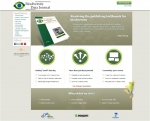

|
 |
|
|   |
| |
The Biodiversity Data Journal: Readable by humans and machines
17.09.2013 |
 The Biodiversity Data Journal (BDJ - http://biodiversitydatajournal.com/) and the associated Pensoft Writing Tool (PWT - http://pwt.pensoft.net/), launched on 16th of September 2013, offer several innovations - some of them unique - at every stage of the publishing process. The workflow allows for authoring, peer-review and dissemination to take place within the same online, collaborative platform. The Biodiversity Data Journal (BDJ - http://biodiversitydatajournal.com/) and the associated Pensoft Writing Tool (PWT - http://pwt.pensoft.net/), launched on 16th of September 2013, offer several innovations - some of them unique - at every stage of the publishing process. The workflow allows for authoring, peer-review and dissemination to take place within the same online, collaborative platform.
Open access to content and data is quickly becoming the prevailing model in academic publishing, resulting in part from changes to policies of governments and funding agencies and in part from scientist's desire to get their work more widely read and used. Open access benefits scientists with greater dissemination and citation of their work, and provides society as a whole access to the latest research.
To publish effectively in open access, it is not sufficient simply to provide PDF files online. It is crucial to put them under a reuse-friendly license and to implement technologies that allow machine-readable content and data to be harvested by computers that can collate small scattered data into a big pool. Analyses and modelling of community-owned big data are the only way to confront environmental challenges to society, such as climate change, ecosystems destruction, biodiversity loss and others.
Manuscripts are not submitted to BDJ in the usual way, as word processor files, but are written in the online, collaborative Pensoft Writing Tool (PWT), that provides a set of pre-defined, but flexible article templates. Authors may work on a manuscript and invite external contributors, such as mentors, potential reviewers, linguistic and copy editors, and colleagues, who may read and comment on the text before submission. When a manuscript is completed, it is submitted to the journal with a simple click of a button. The tool also allows automated import of manuscripts from data management platforms, such as Scratchpads.
"This is the first workflow ever to support the full life cycle of a manuscript, from initial drafting through submission, community peer-review, publication and dissemination within a single, online, collaborative platform. By publishing papers in all branches of biodiversity science, including novel article types, such as data papers and software descriptions, BDJ becomes a gateway for either large or small data into the emerging world of "big data", said Prof. Lyubomir Penev, managing director and founder of Pensoft Publishers.
BDJ shortens the distance between "narrative (text)" and "data" publishing. Many data types, such as species occurrences, checklists, measurements and others, are converted into text from spreadsheets into a human-readable format. Conversely text from an article can be downloaded as structured data or harvested by computers for further use.
A novel community-based peer-review provides the opportunity for a large number of specialists in the field to review a manuscript. Authors may also opt for an entirely public peer-review process. Reviewers may opt to be anonymous or to disclose their names. Editors no longer need to check different reviewers' and author's versions of a manuscript because all versions can be consolidated into a single online document, again at the click of a button.
"The Biodiversity Data Journal is not just a journal, not even a data journal in the conventional sense. It is a completely novel workflow and infrastructure to mobilise, review, publish, store, disseminate, make interoperable, collate and re-use data through the act of scholarly publishing!" concluded Dr Vincent Smith from the Natural History Museum in London, the journal's Editor-in-Chief.
The platform has been designed by Pensoft Publishers and was funded in part by the European Union's Seventh Framework Program (FP7) project ViBRANT.
###
Original Source
Smith V, Georgiev T, Stoev P, Biserkov J, Miller J, Livermore L, Baker E, Mietchen D, Couvreur T, Mueller G, Dikow T, Helgen K, Frank J, Agosti D, Roberts D, Penev L (2013) Beyond dead trees: integrating the scientific process in the Biodiversity Data Journal. Biodiversity Data Journal 1: e995. DOI: http://dx.doi.org/10.3897/BDJ.1.e995
| | all news » |
« Back  Print view Print view
| |
|
|